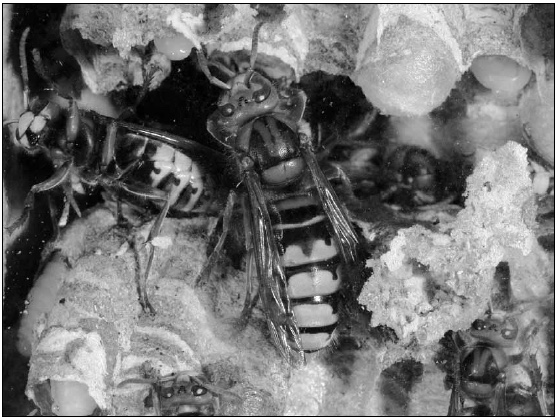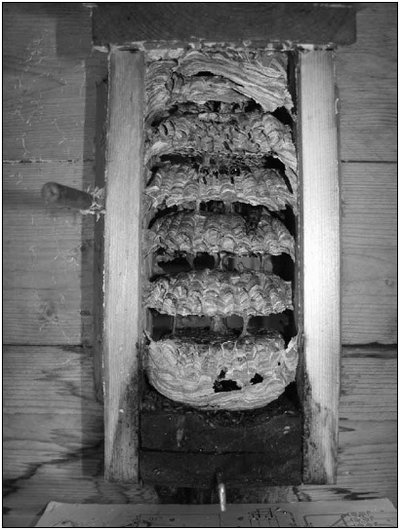Hornets are better than their reputation
Hornets are better than their reputation
The exterminator is not always needed!
by Heini Hofmann*
The big yellow buzzing insects are star architects of lightweight construction. Their impressive nests with integrated thermoregulation are filigree lightweight constructions made from chipped wood shavings mixed with saliva. The fact that hornets’ nests are still being destroyed today is not just about fear, but also about superstition and prejudice.

Probably because of their size (female worker 2-2.5 cm, queen 4 cm) and their fast flight, but also because of the yellow warning colour and the red chest part, we humans feel the largest state-forming insect as particularly menacing. Wrongly so!
Caution yes, panic no
Yet, all, fear and panic are out of place. Hornets are much better than their reputation. They are useful insect exterminators and thus fulfil an important task in nature’s household. Their main prey is flies which they often catch in flight. Also, they are far less intrusive than wasps and neither aggressive nor sting happy (except near the nest). The superstitious vernacular rule, “three stitches kill one man, seven a horse” is simply wrong. A hornet sting is admittedly painful, but not more dangerous than that of a bee (for insect allergy sufferers, the same rules of conduct apply as in a bee sting).
We humans are not threatened by the hornets, but the other way around, since, due to our intervention their habitat is no longer intact. Similar to the colonies of wasps and bumblebees, hornet colonies live for only a year. The workers and the male drones die the latest at the onset of winter, and only the mated queens endure the cold season in fissures, tree gaps or bug bores.
But only every tenth queen manages to found a new colony in spring. Because the dangers are many such as fungal infections, cold spells, lack of food and, unfortunately, because of our exterminator keenness the dangerous search for nesting opportunities. Because natural dwellings such as decaying and hollow trees or woodpecker caves are becoming increasingly rare, hornet queens are found in bird nesting boxes, barns and attics. Rarely, they also nest in the ground.
Ingenious building biology
Because of the mostly unfounded fear of hornets, we are denied the fascinating insight into their ingeniously constructed nests. The courageous people who come to terms with their hornets at their house or on their balcony prove that things can be done differently. It is usually easy. Apart from this, such a coexistence may discover a marvel earth. For even insects and especially those big buzzing insects have to protect themselves from environmental influences in their dwelling that equals mass housing. They do this brilliantly and in a highly professional manner.
Old nests are no longer used. A hibernated queen begins a new nest by attaching the first cells to a thin stalk and placing an egg over it. In this small honeycomb she raises the first workers. Unlike the bees, the nest material is not wax but some kind of paper. Soft, rotten wood is abraded with the mandibles/jaws/ and mixed with saliva functioning as a glue and thus formed into small beads.
Initially, the queen has to do all the work by herself until she can concentrate on laying eggs after the hatching of the first workers. The workers now expand, enlarge and encase the nest. Like all insects, hornets also show high heat loss due to an unfavourable ratio of body surface area and volume. This is why the nest, which is composed of tower-like superimposed honeycomb plates, is surrounded by an insulating shell consisting of air chambers. It keeps the heat in the nest area and leads it to the hatch.
Tricky Sterzeln
In addition, the hornets can regulate the nesting temperature very precisely and on cool nights reduce heat loss. In case of imminent overheating though, when the air in the nest is humid and therefore more energetic than the outside air, the hornets use a trick that honey bees are also familiar with: the Sterzeln. At the nest entrance, with ventilating wing beats they provide ventilation, thus discharging energy from the interior of the nest.
The wood-based building material of the hornets is also hygroscopic. It binds water. Hence it absorbs moisture at night and gives off condensation heat in the nest room at the same time, while during the day it reduces the heat by cooling evaporation. The hornets know to reinforce this effect by targeted moisture entry and additional air exchange.
An ingenious system for an insect that has a brain only the size of a pinhead! Thanks to this fascinating lightweight construction with integrated, extremely efficient thermoregulation, the hornets have in their nests until late autumn a constant hatching temperature of about 29° C.
Mentor nature
Hornets are therefore both, star architects of lightweight construction and world champion in building biology! No wonder that such a phenomenon is of interest to the material sciences. Is there a bionic potential here, that is, can new technical solutions be derived from the construction of the social hymenoptera, for example for facade engineering? Or can thermodynamic mechanisms be used in timber construction? It would not be the first time that man learns from nature! •
(Translation Current Concens)


isolating shell. (picture Gunther Klenk)
Tricky Sterzeln
In addition, the hornets can regulate the nesting temperature very precisely and on cool nights reduce heat loss. In case of imminent overheating though, when the air in the nest is humid and therefore more energetic than the outside air, the hornets use a trick that honey bees are also familiar with: the Sterzeln. At the nest entrance, with ventilating wing beats they provide ventilation, thus discharging energy from the interior of the nest.
The wood-based building material of the hornets is also hygroscopic. It binds water. Hence it absorbs moisture at night and gives off condensation heat in the nest room at the same time, while during the day it reduces the heat by cooling evaporation. The hornets know to reinforce this effect by targeted moisture entry and additional air exchange.
An ingenious system for an insect that has a brain only the size of a pinhead! Thanks to this fascinating lightweight construction with integrated, extremely efficient thermoregulation, the hornets have in their nests until late autumn a constant hatching temperature of about 29° C.
Mentor nature
Hornets are therefore both, star architects of lightweight construction and world champion in building biology! No wonder that such a phenomenon is of interest to the material sciences. Is there a bionic potential here, that is, can new technical solutions be derived from the construction of the social hymenoptera, for example for facade engineering? Or can thermodynamic mechanisms be used in timber construction? It would not be the first time that man learns from nature! •
(Translation Current Concens)
Living storage pots
hh. The honeycomb cells in the hornets’ nest are directed downwards, just like stalactites in stalactites. Eggs and young larvae stick to the cell roof so they don‘t fall out. The white-grey maggots have neither legs and wings nor feelers and eyes, but strong masticatory tools and lateral bulges with which they cling to the cell wall - in the last two of a total of five development stages.
Because the hungry offspring demand a lot of animal food, the field workers carry insects, from flies and grasshoppers to dragonflies, but also wasps and occasionally bees. Overpowered and bitten to death, the loot-animals are usually in flight. Before being introduced, the victims are crushed and chewed to form feedable meat clots.
If the ravenous larvae do not receive enough food, they protest with „hunger scratches“: they throw their heads sweepingly forward and scratch the cell wall wood with their masticatory tools. If one of the maggots starts, the others go along, in the same rhythm as the pre-scratcher.
Hornet larvae are not only fed and coddled. If the food availability is limited due to bad weather, the adult animals - because they do not build up food storage - use their own brood by tickling the larvae until they secrete a nutritious drop of saliva. This causes the larvae to lose half their weight, but the survival of the colony is ensured. Combined youth and old-age provision!
The field workers need less protein than carbohydrate-containing nourishment for their own flight muscles. However, because they only have limited access to nectar because of their short proboscis, they use fallen fruit and honeydew (= excretion of aphids) as well as sap from bleeding trees. Hornets are therefore not nectar-collecting visitors to flowers.
(Translation Current Concerns)
Research object
hh. It is not for nothing that science is interested in the ingenious design of the largest hymenoptera. For example, researchers from Empa (Swiss Federal Institute of Materials Testing) in the Swiss city of Dübendorf in cooperation with the Institute of Structural Engineering at ETH Zurich conducted an unusual experiment on the Empa roof with two hornet populations in order to gain a better understanding of the thermodynamic behaviour of timber structures and to enable applications of these mechanisms.
Adaptations in multi-layered, ventilated building envelopes or the utilisation of the hygroscopic potential of the building material wood are conceivable by integrating it into the building envelope as a passive damper against undesired fluctuations in the internal climate.
(Translation Current Concerns)